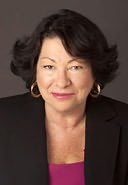- Shopping Bag ( 0 items )
From Barnes & Noble
Sonia Sotomayor did not seem destined for greatness. Born into a Bronx housing project, she was the daughter of an alcoholic who died when she was only nine, not long before she herself was diagnosed with juvenile diabetes. Few would have predicted that she would go to Princeton or Yale Law School on full scholarships, or be selected by three presidents to high judicial post; the last being her 2009 appointment to the U.S. Supreme Court by Barack Obama. She was the first Hispanic and only the third woman to seat on our nation's highest court. A reader-favorite Barnes & Noble Bestseller; now in trade paperbacks and NOOK Books in English and Spanish language editions.





Overview
The first Hispanic and third woman appointed to the United States Supreme Court, Sonia Sotomayor has become an instant American icon. Now, with a candor and intimacy never undertaken by a sitting Justice, she recounts her life from a Bronx housing project to the federal bench, a journey that offers an inspiring testament to her own extraordinary determination and the power of believing in oneself.
Here is the story of a precarious childhood, with an alcoholic father (who would ...